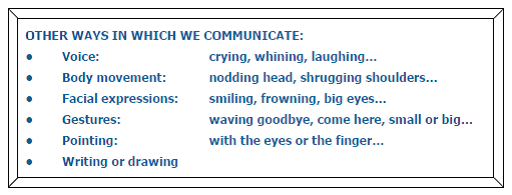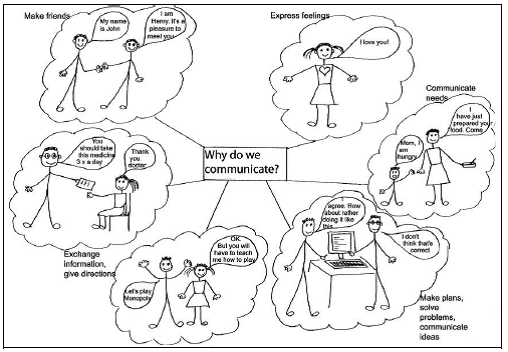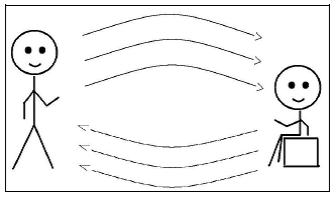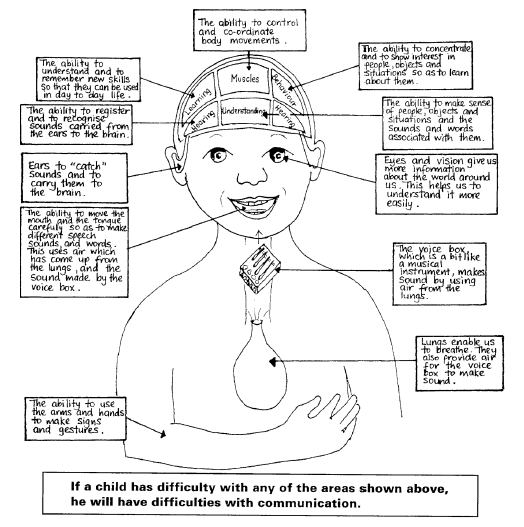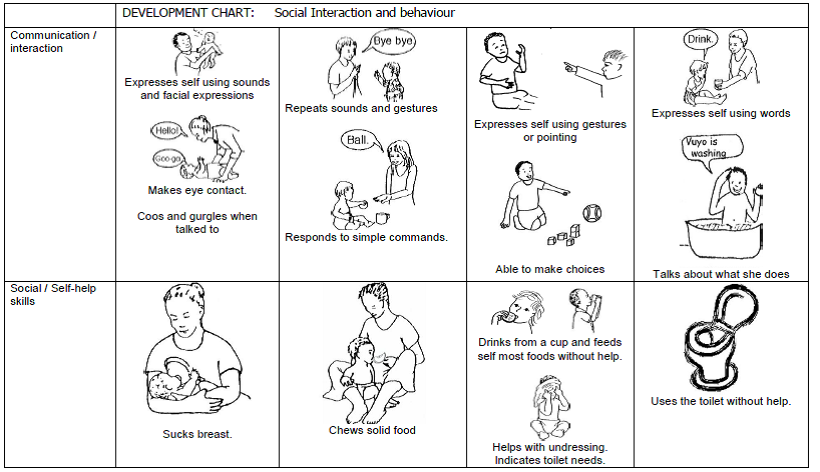Module 4: Communication: Difference between revisions
Michelle Lee (talk | contribs) (Created page with "== Page Outcomes == When you have finished this workshop, you should understand and be able to explain to someone else: *What communication is *Why it is so importan...") |
Michelle Lee (talk | contribs) No edit summary |
||
| Line 1: | Line 1: | ||
== Page Outcomes == | == Page Outcomes == | ||
When you have finished this workshop, you should understand and be able to explain to someone else: | When you have finished this workshop, you should understand and be able to explain to someone else: | ||
*What communication is | *What communication is | ||
*Why it is so important | *Why it is so important | ||
*What you can do to help a child communicate | *What you can do to help a child communicate | ||
== Communication == | == Communication == | ||
There are many forms of communication other that speaking: | There are many forms of communication other that speaking: | ||
[[Image: | [[Image:Communication CP.png|center]] | ||
Now lets take a further look at how we communicate with each oher. | Now lets take a further look at how we communicate with each oher. | ||
[[Image: | [[Image:How communicate.png|center]]Here are some important reasons for communicating: | ||
*Establish relationships and make friends. | *Establish relationships and make friends. | ||
*Exchange information, communicate ideas and give directions. | *Exchange information, communicate ideas and give directions. | ||
*Communicate needs and wishes. | *Communicate needs and wishes. | ||
*Develop thinking skills e.g. help us to remember, make plans, solve problems. | *Develop thinking skills e.g. help us to remember, make plans, solve problems. | ||
*Become happy and successful members of our community. | *Become happy and successful members of our community. | ||
If you try to talk to someone with your mouth full of food, or while holding your tongue in your cheek, the other person will find it difficult to understand you. And it will also be difficult for you to make yourself understood. Or to express yourself. | If you try to talk to someone with your mouth full of food, or while holding your tongue in your cheek, the other person will find it difficult to understand you. And it will also be difficult for you to make yourself understood. Or to express yourself. | ||
<br>Here then is our definition of communication: | <br>Here then is our definition of communication: | ||
[[Image: | [[Image:Def communication.png|center]]<br>This forms a cycle of communication: | ||
[[Image: | [[Image:Cycle of communication.png|center]]In a child with cerebral palsy, this cycle often breaks down. | ||
<br>Why would a child with cerebral palsy may have difficulty communicating? | <br>Why would a child with cerebral palsy may have difficulty communicating? | ||
<br>The following diagram shows that many parts of the brain are needed to be able to communicate without difficulty. This includes those parts of the brain controlling body movements, those interpreting information from the senses, and parts used in thinking, remembering and<br>understanding. Keep in mind that children with cerebral palsy may have difficulties with some or many of these. The more areas that a child has difficulties with, the more severe the communication problem will be. | <br>The following diagram shows that many parts of the brain are needed to be able to communicate without difficulty. This includes those parts of the brain controlling body movements, those interpreting information from the senses, and parts used in thinking, remembering and<br>understanding. Keep in mind that children with cerebral palsy may have difficulties with some or many of these. The more areas that a child has difficulties with, the more severe the communication problem will be. | ||
To understand a message you need: | To understand a message you need: | ||
*Ears and/eyes to see and hear the message | *Ears and/eyes to see and hear the message | ||
*The part of your brain that makes sense of what you have heard or seen (intellect) | *The part of your brain that makes sense of what you have heard or seen (intellect) | ||
To express yourself you need: | To express yourself you need: | ||
*The intellect to know how to express yourself | *The intellect to know how to express yourself | ||
*Mouth and throat to work to make sounds and words out of the sounds (tongue and mouth) | *Mouth and throat to work to make sounds and words out of the sounds (tongue and mouth) | ||
*Control of your body parts to make expressions/ gestures | *Control of your body parts to make expressions/ gestures | ||
[[Image: | [[Image:Child with cp communication.png|center]]Let's look at where it breaks down. | ||
A child who has cerebral palsy and who has an intellectual disability (that is, who is slow to learn): | A child who has cerebral palsy and who has an intellectual disability (that is, who is slow to learn): | ||
*Will have difficulty with both steps -- understanding and expressing. | *Will have difficulty with both steps -- understanding and expressing. | ||
*How much difficulty depends on the extent and areas of damage in the brain. | *How much difficulty depends on the extent and areas of damage in the brain. | ||
A child who has cerebral palsy and has no intellectual disability: | A child who has cerebral palsy and has no intellectual disability: | ||
*Will not have difficulty with understanding. | *Will not have difficulty with understanding. | ||
*If she can talk, she will be able to express herself, though it may be a bit unclear. | *If she can talk, she will be able to express herself, though it may be a bit unclear. | ||
*If she cannot talk, it may be difficult for her to express herself and very often she is then labeled as having an intellectual disability. | *If she cannot talk, it may be difficult for her to express herself and very often she is then labeled as having an intellectual disability. | ||
*She will need to be taught and encouraged in other ways to express herself, otherwise her communication cycle breaks down. | *She will need to be taught and encouraged in other ways to express herself, otherwise her communication cycle breaks down. | ||
Look again at the communication part of our development chart: | Look again at the communication part of our development chart: | ||
[[Image: | [[Image:Development chart 2.png|center]] | ||
*Communication skills develop according to a sequence of steps. | |||
*From birth the baby expresses herself using sounds (e.g. crying) and facial expressions. | |||
*To encourage the child to interact, it is important that she learns to make and maintain eye contact. At first she may only look at you briefly but later she may be able to keep eye contact for longer. Babies are initially more interested in faces and then later in objects. | |||
*She learns about taking turns when her mother responds to her sounds. She may start to coo and gurgle when talked to and may later be able to repeat sounds and gestures. | |||
*Observe for gestures / sounds that she may use to express herself, and respond consistently and immediately to any attempt she uses to initiate communication. This will encourage her to communicate. | |||
*As her understanding improves she will start to respond to simple commands. | |||
*Give your child choices during the day. This can increase her motivation to let you know what she wants. For example, let her choose between two different tops/pants or skirt when dressing her in the morning. You could also let her choose whether she wants something to eat or something to drink first at a mealtime. | |||
*Listening and understanding comes before talking, as we can see from the chart. | |||
*Learning that prepares a baby for speech begins early, long before she says her first word.<br> | |||
*We know that most children with cerebral palsy can hear, so they listen to the words you say and in time (usually) they begin to use words themselves. | |||
*Babies need to learn to chew to help develop control of the movements of their tongue, cheeks, and lips. This is very important for the development of talking. (Many children who have difficulties controlling their tongue and mouth often get given ONLY soft food -- so they never really practice using their mouth and tongue). | |||
*Important: Make sure you attend to any sign of earache in your child. If left untreated, this could lead to ear damage and loss of hearing. | |||
*Remember in the first training module we mentioned that children with athetoid type of cerebral palsy often have hearing loss which could require use of a hearing aid! | |||
'''Tallk to her!''' | |||
Here are some ideas of how to talk to a child: | |||
Revision as of 18:37, 22 September 2016
Page Outcomes[edit | edit source]
When you have finished this workshop, you should understand and be able to explain to someone else:
- What communication is
- Why it is so important
- What you can do to help a child communicate
Communication[edit | edit source]
There are many forms of communication other that speaking:
Now lets take a further look at how we communicate with each oher.
Here are some important reasons for communicating:
- Establish relationships and make friends.
- Exchange information, communicate ideas and give directions.
- Communicate needs and wishes.
- Develop thinking skills e.g. help us to remember, make plans, solve problems.
- Become happy and successful members of our community.
If you try to talk to someone with your mouth full of food, or while holding your tongue in your cheek, the other person will find it difficult to understand you. And it will also be difficult for you to make yourself understood. Or to express yourself.
Here then is our definition of communication:
This forms a cycle of communication:
In a child with cerebral palsy, this cycle often breaks down.
Why would a child with cerebral palsy may have difficulty communicating?
The following diagram shows that many parts of the brain are needed to be able to communicate without difficulty. This includes those parts of the brain controlling body movements, those interpreting information from the senses, and parts used in thinking, remembering and
understanding. Keep in mind that children with cerebral palsy may have difficulties with some or many of these. The more areas that a child has difficulties with, the more severe the communication problem will be.
To understand a message you need:
- Ears and/eyes to see and hear the message
- The part of your brain that makes sense of what you have heard or seen (intellect)
To express yourself you need:
- The intellect to know how to express yourself
- Mouth and throat to work to make sounds and words out of the sounds (tongue and mouth)
- Control of your body parts to make expressions/ gestures
Let's look at where it breaks down.
A child who has cerebral palsy and who has an intellectual disability (that is, who is slow to learn):
- Will have difficulty with both steps -- understanding and expressing.
- How much difficulty depends on the extent and areas of damage in the brain.
A child who has cerebral palsy and has no intellectual disability:
- Will not have difficulty with understanding.
- If she can talk, she will be able to express herself, though it may be a bit unclear.
- If she cannot talk, it may be difficult for her to express herself and very often she is then labeled as having an intellectual disability.
- She will need to be taught and encouraged in other ways to express herself, otherwise her communication cycle breaks down.
Look again at the communication part of our development chart:
- Communication skills develop according to a sequence of steps.
- From birth the baby expresses herself using sounds (e.g. crying) and facial expressions.
- To encourage the child to interact, it is important that she learns to make and maintain eye contact. At first she may only look at you briefly but later she may be able to keep eye contact for longer. Babies are initially more interested in faces and then later in objects.
- She learns about taking turns when her mother responds to her sounds. She may start to coo and gurgle when talked to and may later be able to repeat sounds and gestures.
- Observe for gestures / sounds that she may use to express herself, and respond consistently and immediately to any attempt she uses to initiate communication. This will encourage her to communicate.
- As her understanding improves she will start to respond to simple commands.
- Give your child choices during the day. This can increase her motivation to let you know what she wants. For example, let her choose between two different tops/pants or skirt when dressing her in the morning. You could also let her choose whether she wants something to eat or something to drink first at a mealtime.
- Listening and understanding comes before talking, as we can see from the chart.
- Learning that prepares a baby for speech begins early, long before she says her first word.
- We know that most children with cerebral palsy can hear, so they listen to the words you say and in time (usually) they begin to use words themselves.
- Babies need to learn to chew to help develop control of the movements of their tongue, cheeks, and lips. This is very important for the development of talking. (Many children who have difficulties controlling their tongue and mouth often get given ONLY soft food -- so they never really practice using their mouth and tongue).
- Important: Make sure you attend to any sign of earache in your child. If left untreated, this could lead to ear damage and loss of hearing.
- Remember in the first training module we mentioned that children with athetoid type of cerebral palsy often have hearing loss which could require use of a hearing aid!
Tallk to her! Here are some ideas of how to talk to a child:
